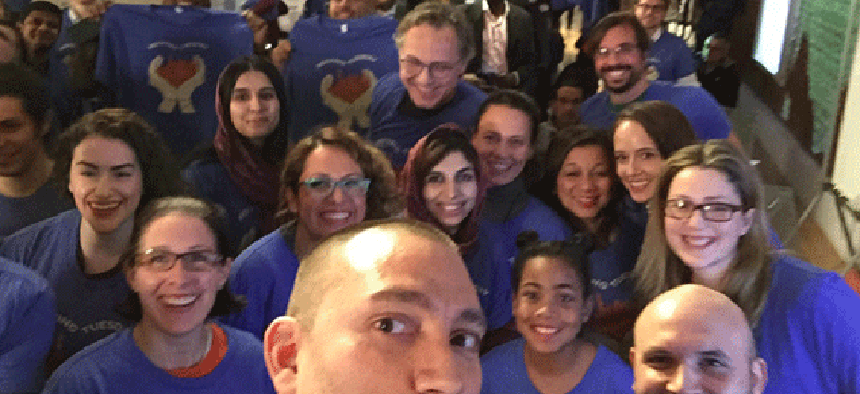As Giving Tuesday Evolves, Nonprofits Adapt

From an altruistic ideation of the 92nd Street Y and the United Nations Foundation back in 2012, the Tuesday following Thanksgiving has matured into a resolute foil to the consumerism of Black Friday and Cyber Monday. Giving Tuesday, as it’s now widely known, is responsible for a 470 percent increase in online charitable donations on that particular day of the year. But as more and more nonprofits in the New York area look to capitalize on the #GivingTuesday movement, it seems substantial online exposure is requiring an already savvy sector to react in some inventive ways.
Since the first Giving Tuesday, which involved corporations and donors making donations and promoting worthy causes on social media, the movement has garnered over 15 billion social media impressions with over 32 million impressions on Twitter alone, thanks, in part, to the 30,000 partners of the 92nd Street Y from around the world.
Big-name corporations, like Google and Microsoft, have even tacked onto the day of charity by donating and sponsoring volunteer days. In 2013, on the second-ever Giving Tuesday, Bill Gates wrote on his blog, “Giving Tuesday is part of a larger trend that I find very encouraging: Technology is creating the opportunity to make philanthropy both more efficient and more effective.” Gates also went on to say that donors, inundated with information about numerous worthy causes, need to do their own research to determine the most impactful use of their money.
In New York City, where this all started and where there’s a high concentration of local nonprofits – not to mention national and international nonprofits – donors have been especially burdened with information overload. As a result, nonprofits in New York have pursued strategies to make themselves stand out and to, more importantly, keep donors active in their organizations.
“When you think about the history of online giving and e-commerce and how it intersects with nonprofits, nonprofits still haven’t figured out the right way to do it, because technology was inserted into a place with a more organic feel,” said co-founder and CEO of Givkwik Jason Rosado. According to Rosado, whose software company connects companies, causes and communities to help simplify and amplify corporate giving, there’s room for local nonprofits to expand their online donor outreach, especially on Giving Tuesday.
For the third year running and for the second time in New York City, Givkwik will be hosting an event that allows attendees and viewers to vote to award a grant to a small-to-medium sized New York City nonprofit. Thus far, 50 nonprofits have completed the free registration process for the GivNYC2015 event. Online voting will whittle these registrants down to the top ten with the most votes. These finalists will then have the opportunity to pitch their nonprofits at the live event on Giving Tuesday. The grant is funded with money from corporate donors. One of the benefits of GivNYC is that it multiplies the impact of many smaller nonprofits’ Giving Tuesday social media efforts and helps to build community by gathering various New York City nonprofits in one room for an opportunity to network and build relationships.
Matt Ronen, founder of last year’s winning nonprofit, Service Year, said that diving into Giving Tuesday was a “powerful move.” Service Year, only a few years old, partners with corporations to select, train, and empower top college graduates to make an immediate social impact by securely deferring their positions at leading private-sector companies for one year of service. Since winning GivNYC2014, the nonprofit has signed contracts with CitiBank and GE. When it comes to raising revenue through donations, Ronen said going to the Internet shouldn’t be the first move for nonprofits, even if it is Giving Tuesday. “Step one is making a connection with an individual,” Ronen said.
Most nonprofits realize that publishing a few tweets or bulk sending emails aren’t effective means of getting donors’ attention. Some additional element or elements need to be added to their marketing mix. For Dress for Success, a nonprofit that provides disadvantaged women with professional attire, this means turning #GivingTuesday into #GivingShoesDay, a day to donate professional footwear at a Dress for Success location. Because of the attachment people have to clothing, especially shoes, says Katie Murphy, director of media relations at Dress for Success Worldwide, the nonprofit hopes to catch donors’ attention, bringing them back throughout the rest of the year. “Giving Tuesday is the first step in relations building with our donors,” she added.
Other nonprofits have come up with innovative ways to find new donors, inspire repeat donors and encourage donor engagement online. The Food Bank for New York created an online virtual food drive where donors can make a $10 contribution to support the purchase of 3 gallons of milk for a Thanksgiving meal. And, like Dress for Success, the food bank merges various giving options and channels to engage all types of donors by offering volunteer opportunities to repack donated food, or purchase one of their holiday cards.
For Friends of Karen, a nonprofit working with critically ill children and their families, “segmenting” helps maximize fundraising opportunities. Through this method, Friends of Karen targets members of their donating community deliberately based on known interests. If a donor is drawn to services for siblings of critically ill children or to helping families pay medical bills, then the nonprofit will keep the donor updated on efforts and needs in those particular areas. Lisa Dashman, strategic marketing and development director for Friends of Karen, believes donors want to have a connection that goes beyond simply writing a check, and that is something online outreach alone cannot do. “Fundraising efforts are never going to get to a point where they’re homogenized,” Dashman said.
